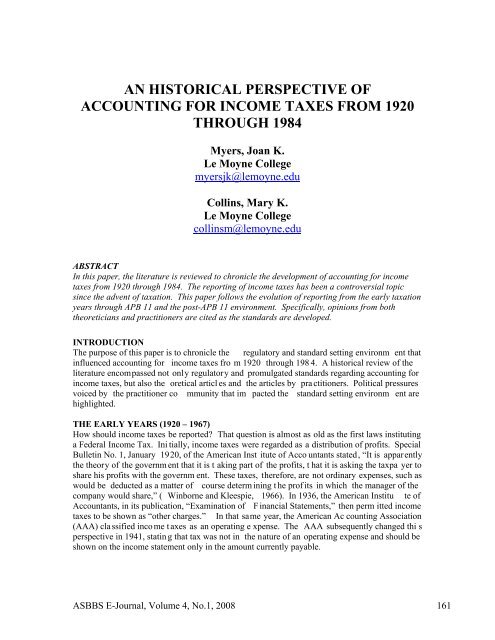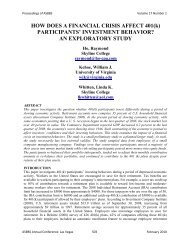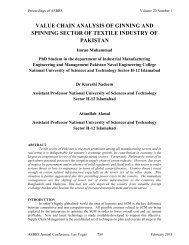stock repurchase announcements: a test of market ... - Asbbs.org
stock repurchase announcements: a test of market ... - Asbbs.org
stock repurchase announcements: a test of market ... - Asbbs.org
You also want an ePaper? Increase the reach of your titles
YUMPU automatically turns print PDFs into web optimized ePapers that Google loves.
AN HISTORICAL PERSPECTIVE OF<br />
ACCOUNTING FOR INCOME TAXES FROM 1920<br />
THROUGH 1984<br />
Myers, Joan K.<br />
Le Moyne College<br />
myersjk@lemoyne.edu<br />
Collins, Mary K.<br />
Le Moyne College<br />
collinsm@lemoyne.edu<br />
ABSTRACT<br />
In this paper, the literature is reviewed to chronicle the development <strong>of</strong> accounting for income<br />
taxes from 1920 through 1984. The reporting <strong>of</strong> income taxes has been a controversial topic<br />
since the advent <strong>of</strong> taxation. This paper follows the evolution <strong>of</strong> reporting from the early taxation<br />
years through APB 11 and the post-APB 11 environment. Specifically, opinions from both<br />
theoreticians and practitioners are cited as the standards are developed.<br />
INTRODUCTION<br />
The purpose <strong>of</strong> this paper is to chronicle the regulatory and standard setting environm ent that<br />
influenced accounting for income taxes fro m 1920 through 198 4. A historical review <strong>of</strong> the<br />
literature encompassed not only regulatory and promulgated standards regarding accounting for<br />
income taxes, but also the oretical articl es and the articles by pra ctitioners. Political pressures<br />
voiced by the practitioner co mmunity that im pacted the standard setting environm ent are<br />
highlighted.<br />
THE EARLY YEARS (1920 – 1967)<br />
How should income taxes be reported? That question is almost as old as the first laws instituting<br />
a Federal Income Tax. Ini tially, income taxes were regarded as a distribution <strong>of</strong> pr<strong>of</strong>its. Special<br />
Bulletin No. 1, January 1920, <strong>of</strong> the American Inst itute <strong>of</strong> Acco untants stated, “It is apparently<br />
the theory <strong>of</strong> the governm ent that it is t aking part <strong>of</strong> the pr<strong>of</strong>its, t hat it is asking the taxpa yer to<br />
share his pr<strong>of</strong>its with the governm ent. These taxes, therefore, are not ordinary expenses, such as<br />
would be deducted as a matter <strong>of</strong> course determ ining t he pr<strong>of</strong> its in which the manager <strong>of</strong> the<br />
company would share,” ( Winborne and Kleespie, 1966). In 1936, the American Institu te <strong>of</strong><br />
Accountants, in its publication, “Examination <strong>of</strong> F inancial Statements,” then perm itted income<br />
taxes to be shown as “other charges.” In that same year, the American Ac counting Association<br />
(AAA) cla ssified inco me t axes as an operating e xpense. The AAA subsequently changed thi s<br />
perspective in 1941, statin g that tax was not in the nature <strong>of</strong> an operating expense and should be<br />
shown on the income statement only in the amount currently payable.<br />
ASBBS E-Journal, Volume 4, No.1, 2008 161

















